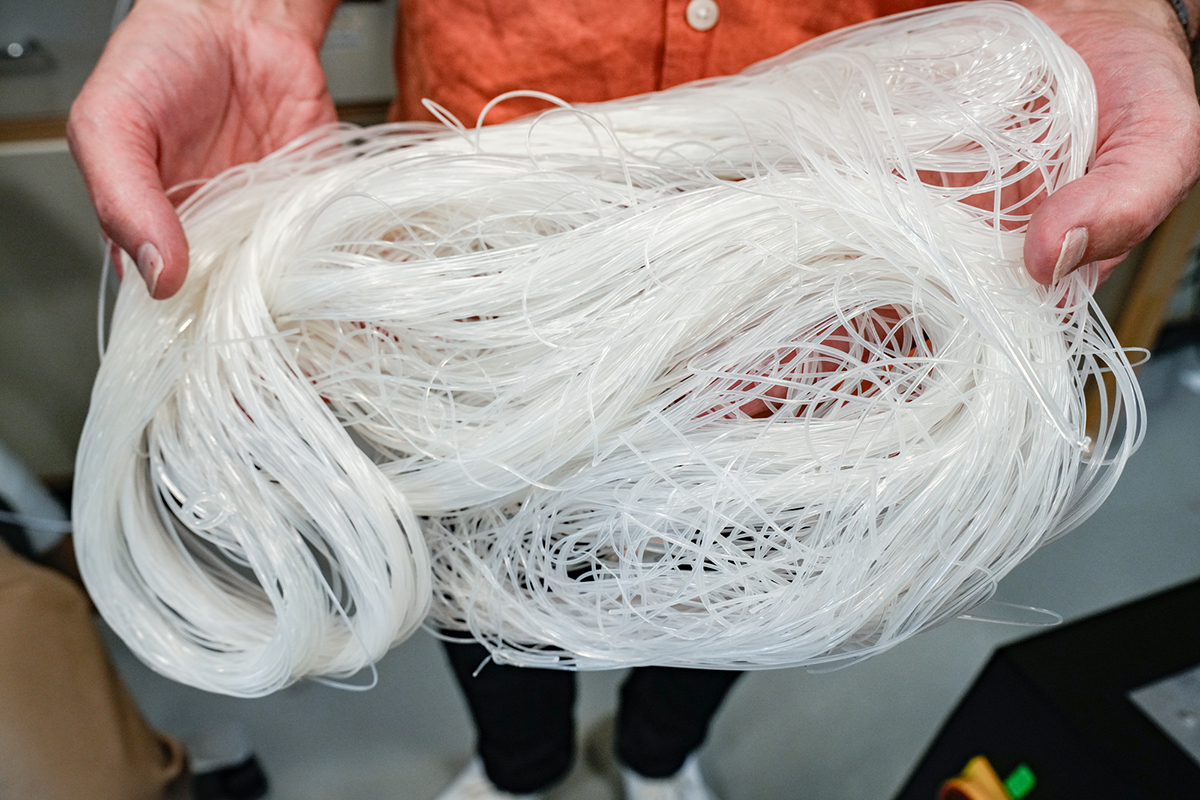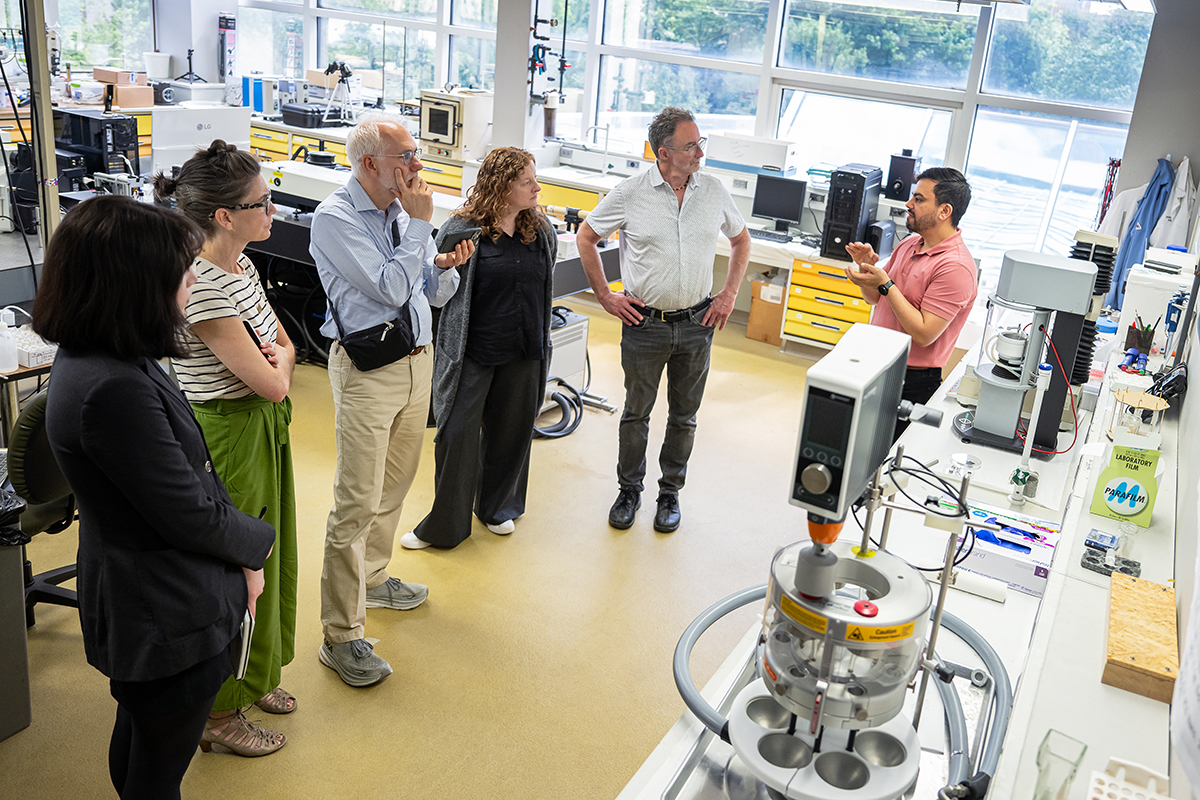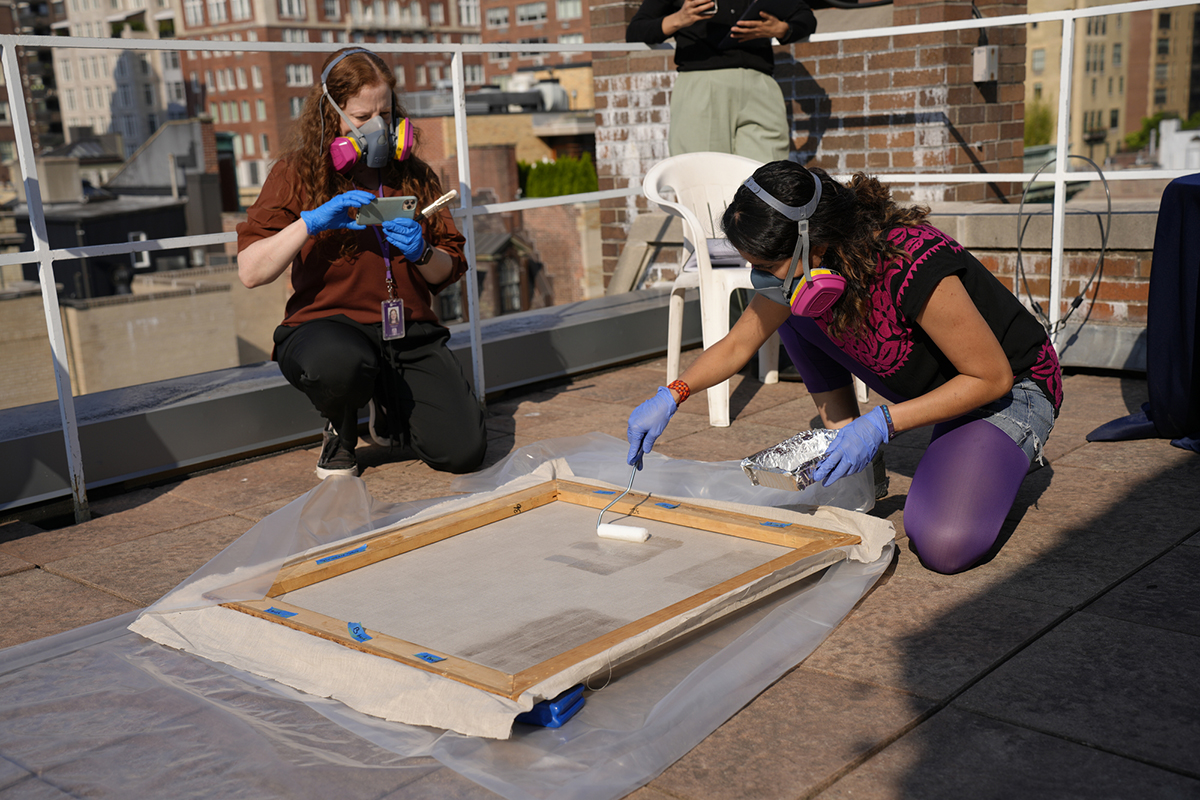UA polymer research revolutionizes global art conservation field

The new solvent-free, spaghetti-like version of BEVA 371 Akron before it is trimmed into pellets and packaged for distribution. Photo by Nita L. Roberts.
Researchers at the University of Akron (UA), along with partners at the Getty Foundation and New York University (NYU), have developed a revolutionary formulation of an adhesive that will be used by art conservators around the world and highlights UA’s place as an international leader in polymer research.
The breakthrough is the result of a major conservation science research grant funded by Getty, a Los Angeles-based foundation that supports individuals and institutions committed to advancing the greater understanding and preservation of the visual arts in Los Angeles and throughout the world. Getty, UA and NYU announced the development of the adhesive and presented results of the research project at the annual American Institute of Conservation conference May 27-31 in Minneapolis, Minn.
The adhesive, which will be known as BEVA 371 Akron in recognition of the University’s contributions, is a safer and more sustainable substitute for BEVA 371, an adhesive that for decades was used by conservators worldwide in the structural treatment of paintings on canvas and related artistic media. The research for BEVA 371 Akron was done in the lab of Dr. Ali Dhinojwala, W. Gerald Austen Endowed Chair and H.A. Morton Professor in the College of Engineering and Polymer Science at UA.
Where Polymers and Art Connect
UA researchers take on the challenge
Developed in 1972 by Austrian American painting conservator Gustav Berger, the original Berger’s Ethylene Vinyl Acetate (BEVA) formula became a popular adhesive used in the conservation field. Paintings in museums may require a supplemental canvas attached to the back of the artwork, through a treatment called lining, which protects aging artworks so they can continue to be safely displayed. Numerous lining techniques exist, and materials like BEVA 371 are used to adhere new lining canvases to the reverse of the original support. The BEVA 371 adhesive quickly became known for its strength and non-penetrating qualities, which eliminated the risks associated with earlier systems whose components could penetrate through the paint layers and cause them to appear stained and darker than intended by the artist. The first painting in a museum collection to be lined with BEVA 371 was “Paris Through a Window” by Marc Chagall, which is in the collection of the Solomon R. Guggenheim Museum in New York. Thousands of artworks in institutions worldwide have been repaired with BEVA 371.
The original BEVA 371 formula, which relied on industrial heat seal adhesive technology, was well-suited for artworks due to its long window of viscosity and relatively low melting point. However, a critical ingredient, Laropal K-80, went out of commercial production in 2005 and another component, a phthalate tackifier called Cellolyn 21E, was discontinued in 2020.
As part of its Conserving Canvas initiative, the Getty Foundation awarded a research grant in 2021 to NYU’s Conservation Center of the Institute of Fine Arts, which partnered with the UA College of Engineering and Polymer Science’s School of Polymer Science and Polymer Engineering, the top-ranked polymer science and plastics engineering program in the world, to develop a solution.
“Without these key resins, a major resource for the field of art conservation was lost,” Dhinojwala said. “Finding a satisfactory substitute that matched the original adhesive’s favorable thermal performance was critical to optimizing the material options available to conservators.”

Dharamdeep Jain ’17 (far right) gives a tour of the labs in UA’s Goodyear Polymer Center to a group of researchers and art conservators from Italy and the U.S. who visited campus in June 2024 to learn about the new BEVA 371 Akron art adhesive. Photo by Jason Miller, The University of Akron.
Moving beyond the original formula
After a multi-year collaboration, the newly reformulated BEVA 371 Akron product successfully matches the original formula’s characteristics, while using resins that were not available during Berger’s development of the original formulation. The new version is phthalate-free, making it safer to handle as phthalates are associated with a variety of health risks and are being phased out. The team also took this opportunity to study BEVA 371 Akron’s chemical makeup in detail to better prepare for potential supply chain issues in the future.
“A powerful takeaway from our research was that we have a much better understanding of how the molecular architecture of the system affects performance, allowing us to tailor properties specifically for the conservation community and articulate best practice for their use,” said Chris McGlinchey, project director at NYU and former senior conservation scientist at The Museum of Modern Art in New York. “We’ve conducted rigorous performance testing of the recipe with leading experts, and we are thrilled with the new, conservation-optimized formulation that will provide conservators more ways to work. It’s a big win anytime you enable a conservator to do their work more safely and effectively.”
Among the most significant achievements with BEVA 371 Akron are its sustainability benefits and the fact that it can now be produced in three different versions depending on needs. In addition to the original premixed version, a new, solvent-free solid formulation has a longer shelf life and will be lighter and less costly to ship. Conservators can dissolve the amount they need in the studio, allowing for greater flexibility to control fumes and use new and improved solvents as they emerge in the field. The team is also developing a solvent-free, non-woven formula in which the fibrous structure is pure adhesive.
“The new forms and sustainable attributes of BEVA 371 Akron are a major win for our field and will help conservators lower their environmental impact as they can mix solvents on demand,” said Matteo Rossi Doria, a Rome-based senior paintings conservator and international expert in lining treatments for paintings on canvas.
Rossi Doria helped the research team test formulations to ensure the new recipe met conservators’ standards. “This project has been a long time coming, and we are so glad the new formula is going into production in multiple forms, making it a strong option for conservations across the globe.”
Premixed versions of BEVA 371 Akron are now in production by distributors Conservator’s Products Company (CPC) in New Jersey and CTS in Italy, and the solvent-free, solid form will be available later this year. The solid version is made by extruding the adhesive into long, spaghetti-like noodles. These stretchy fibers are then hardened and trimmed into small pellets before being packaged for distribution.

Graduate students at the Conservation Center of NYU’s Institute of Fine Arts test out the new BEVA 371 Akron formulation on the building’s rooftop in Manhattan. Photo by Nita L. Roberts.
Learning experience for the next generation
Another goal of the project was to harness the collective expertise of senior conservators specialized in lining paintings to transfer these skills to a rising generation of conservators. Graduate students in conservation from NYU’s Institute of Fine Arts and a cohort of early and mid-career conservators from across Europe joined with leading practitioners for hands-on workshops, in which they studied how the original BEVA formulation could be manipulated, tested the new BEVA 371 Akron formulations and learned best practices for its different treatment applications.
“Supporting training that keeps the conservation field strong and adaptable for the future is a core tenet of Getty’s grantmaking,” said Lorinda Wong, senior program officer at the Getty Foundation who oversees conservation initiatives. “Our Conserving Canvas initiative was established in 2018 and we’ve since had the pleasure of having over 250 conservation professionals across the globe participate in our workshops, ensuring conservators receive the resources and latest research required to do their crucial work.”
Conserving Canvas has supported professionals internationally through training projects focused on individual paintings as well as skill-building workshops that enhance conservators’ hands-on experience and technical knowledge to preserve the thousands of canvas paintings under their collective care.
“Out of all the great things that Getty has done with Conserving Canvas, this project is arguably the most important,” said Paul Ackroyd, conservator at The National Gallery, London. “With its advances in materials innovation and sustainability, the project is a shining example of how successful collaboration can be in a niche industry like ours.”
The Getty Foundation fulfills the philanthropic mission of the Getty Trust by supporting individuals and institutions committed to advancing the greater understanding and preservation of the visual arts in Los Angeles and throughout the world. Through strategic grant initiatives, the Foundation strengthens art history as a global discipline, promotes the interdisciplinary practice of conservation, increases access to museum and archival collections, and develops current and future leaders in the visual arts. It carries out its work in collaboration with the other Getty Programs to ensure that they individually and collectively achieve maximum effect. Additional information is available at www.getty.edu/foundation.
About the Conservation Center of the Institute of Fine Arts, New York University
The Institute of Fine Arts is an international leader in research and graduate teaching and is committed to global engagement and advancing the fields of art history, archaeology, and the theory and practice of conservation. New York City, with its incomparable resources and vitality, provides a backdrop and extended campus for the Institute’s activities. Founded in 1960, the Conservation Center is the oldest degree-granting graduate program in art conservation in the United States. The Conservation Center offers a four-year, dual MA/MS graduate program that combines training in conservation with historical, archaeological, curatorial, and scientific studies.
About the School of Polymer Science and Polymer Engineering, The University of Akron
The School of Polymer Science and Polymer Engineering (SPSPE) at The University of Akron (UA) is an international leader in research and education in the field of polymers and is ranked No. 1 in the world in the area of polymer science and plastics engineering. The program offers four-year bachelor’s degrees, two-year master’s degrees and Ph.D. programs in polymer science and polymer engineering. UA introduced the world’s first rubber chemistry course in 1909 and launched the world’s first Ph.D. program in polymer chemistry in 1956. SPSPE has expertise in areas of polymer chemistry, physics, processing and manufacturing. The School’s current research focus is on sustainability and decreasing the dependence on fossil fuels and reducing the carbon footprint in the manufacturing and use of polymers. The UA campus and city of Akron are surrounded by more than 150 companies related to plastics and rubber, creating opportunities for experiential learning and industry partnerships. Learn more at uakron.edu/polymer.
UA media contact: Cristine Boyd, 330-972-6476 or cboyd@uakron.edu
Getty media contact: Cole Calhoun, 310-440-7186 or ccalhoun@getty.edu
